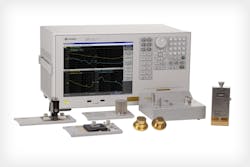Instruments and systems tackle component and IC test
by Rick Nelson
Recent test innovations address components ranging from passive components to integrated circuits. New and enhanced test equipment ranges from bench-top instruments, such as a Keysight impedance analyzer and Anritsu vector network analyzer, to production-ready semiconductor test systems, such as an ATE system from Marvin Test Solutions and a handler from the Multitest unit of Xcerra.
These innovations build on ones described in recent articles, including a report in our October print edition on modular systems for IC test and a companion Web Exclusive feature on IC, sensor, and passive component test. In addition, in a feature in our November print edition, Senior Technical Editor Tom Lecklider offered a backgrounder on LCR measurements and described instruments from from B&K Precision, Chroma Systems Solutions, GWInstek, Hameg Instruments, IET Labs, Keysight Technologies, Stanford Research Systems, Tegam, Thurlby Thandar Instruments, and Wayne Kerr Electronics.
(See “Modular systems automate IC test” and “Test of ICs, sensors, and passive components gets boost” as well as “Bridging the LCR measurement gap.”)
Since those articles went to print, Keysight, Marvin Test Solutions, and Anritsu have all introduced new products or enhanced features.
Keysight, for example, announced shipment of its E4991B impedance analyzer, specifically designed for R&D, quality assurance, and inspection engineers characterizing and evaluating passive electronic components, semiconductor devices, dielectric materials, and magnetic materials.
Keysight’s E4991B offers 0.65% basic accuracy for evaluating components over a wide impedance range, from 1 MHz to 3 GHz. The analyzer features accurate material measurement options that include temperature characteristics analysis from -55°C to 150°C (Option 007) and direct read function of permittivity and permeability up to 1 GHz (Option 002).
(See “Keysight begins shipment of impedance analyzer.”)
In addition, Anritsu expanded its ShockLine family of vector network analyzers (VNAs) with the introduction of the MS46122A Series. Incorporating Anritsu’s patented shock line VNA-on-a-chip technology, the MS46122A low-cost full-reversing 2-port VNAs are packaged in a compact 1U chassis and are optimized for cost-sensitive test applications in manufacturing, engineering, and education environments. cost-sensitive passive device test applications in engineering, manufacturing and education. The ShockLine family can be employed to test RF and automotive connectors and cables, electromechanical switches, attenuators, couplers, filters, isolators, circulators, and phase shifters.
(See “Anritsu introduces PC-controlled ShockLine VNAs.”)
For semiconductor test, Marvin Test Solutions earlier this month introduced the TS-960, the newest version of the company’s TS-900 PXI semiconductor test platform. The TS-960 brings the performance and features of high-end systems to customers at a fraction of the footprint and cost compared with traditional ATE.
“Our semiconductor customers asked for an alternative to big-iron ATE systems that would combine high-performance measurements with a substantially reduced footprint,” said Steve Sargeant, CEO of Marvin Test Solutions. “By using the TS-960 platform and our new GX5296 digital subsystem, customers get a flexible PXI platform with high-performance timing features typically found only in high-end ATE systems.”
(See “MTS adds PMU per pin to PXI-based IC test system.”)
And finally, Xcerra announced that its Multitest MT2168 pick-and-place handler now offers the ability to characterize devices at cold conditions. This capability addresses the evolving requirements for temperature performance driven by end markets. Whereas final test of the respective devices in high volume production will only be done at ambient/hot, they need to get qualified for cold conditions before they ramp. The “Cold for Characterization” option of the MT2168 allows for using the one platform for qualification and final test without the need to invest in more complex and more expensive tri-temp test equipment.
The “Cold for Characterization” set-up of the MT2168 is an add-on to the standard base unit, which does not require changes in the handler itself. All required features are part of the conversion kit set. The customer can decide whether he wants to use existing external chillers or if he prefers to have a LN2-based heat exchanger integrated. The “Cold for Characterization” option provides temperature conditioning directly at the contact site and sticks to the chamberless concept of the MT2168. This way no icing issues or defrost needs occur.
(See “Handler offers package characterization at cold conditions.”)
About the Author

Rick Nelson
Contributing Editor
Rick is currently Contributing Technical Editor. He was Executive Editor for EE in 2011-2018. Previously he served on several publications, including EDN and Vision Systems Design, and has received awards for signed editorials from the American Society of Business Publication Editors. He began as a design engineer at General Electric and Litton Industries and earned a BSEE degree from Penn State.

